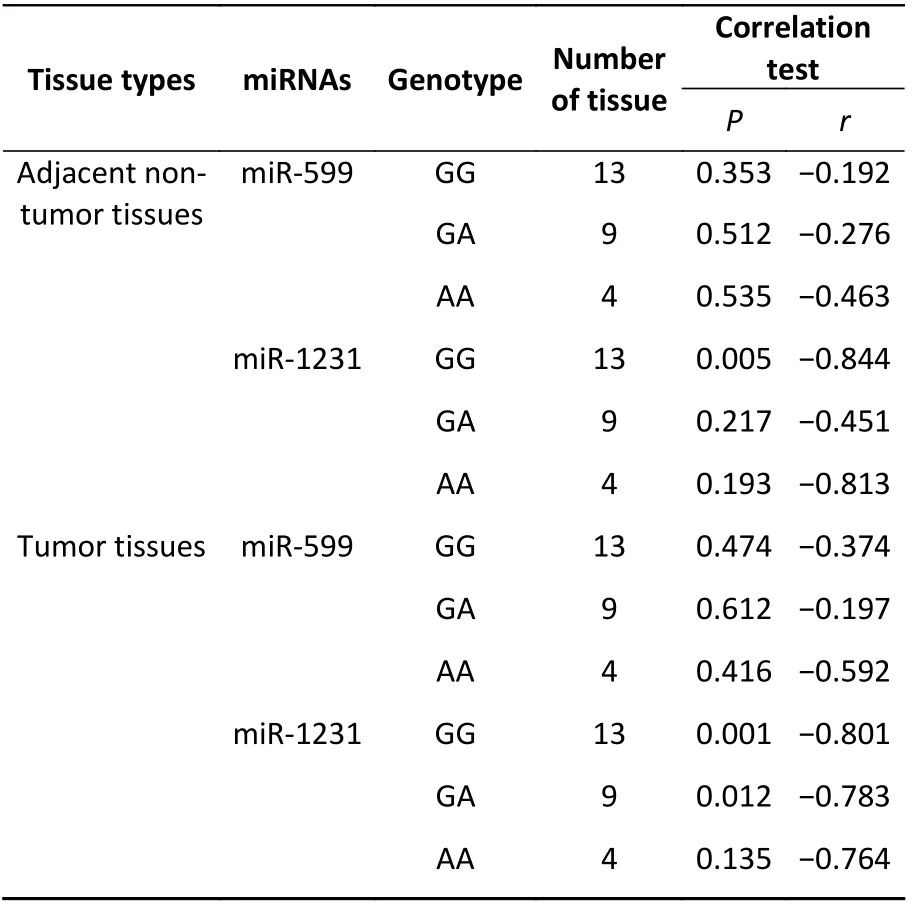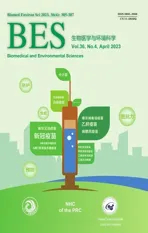rs3735664 Polymorphism Affecting ELFN1-AS1 Adsorption on miR-1231 is Associated with Colorectal Cancer Susceptibility and Tumor Stage*
2023-05-10LIXianYangHUANGZhiJunLIJianPingandGAOXueRen
LI Xian Yang, HUANG Zhi Jun, LI Jian Ping, and GAO Xue Ren,#
Colorectal cancer (CRC) is a common and deadly disease, with over two million new cases and one million deaths in 2020[1].Risk factors include lack of exercise, obesity, high red meat consumption, low intake of fiber, smoking, and alcohol consumption,as well as genetic factors[2,3].ELFN1-AS1, located on chromosome 7p22.3, expresses a pro-oncogenic lncRNA[4-7].Wang et al.reported that exosomalELFN1-AS1from osteosarcoma cells could mediate macrophage M2 polarization by sponging miR-138-5p and miR-1291 to promote osteosarcoma tumorigenesis[4].Lei et al.found thatELFN1-AS1could promote CRC proliferation and migration by modulating the miR-4644/TRIM44 axis[5].Zhang et al.confirmed thatELFN1-AS1could facilitate the progression of esophageal cancer by promoting GFPT1 expression via sponging miR-183-3p[6].Jie et al.found thatELFN1-AS1could accelerate the proliferation, invasion, and migration of ovarian cancer cells by directly interacting with miR-497-3p and then regulating CLDN4 expression[7].These results suggest thatELFN1-AS1promotes the progression of various cancers, including CRC,osteosarcoma, esophageal cancer, and ovarian cancer, by acting as a competing endogenous RNA(ceRNA) and modulating miRNA expression.Bioinformatics analysis shows that a single nucleotide polymorphism (rs3735664 G>A) is located at the binding site ofELFN1-AS1to miR-599 and miR-1231 (Supplementary Figure S1 available in www.besjournal.com)[8].MiR-599 and miR-1231 could be adsorbed by some sponges, which in turn promotes the progression of CRC[9,10].Therefore, the rs3735664 polymorphism may be involved in the development and progression of CRC by affecting the ceRNA function ofELFN1-AS1.
In this study, 1,000 individuals of Chinese Han ethnicity were recruited, 500 of whom were diagnosed with sporadic CRC, confirmed by pathology.The other 500 were cancer-free individuals who had no family history of cancer, had no intestinal disease, and were enrolled in hospital physical examinations (Supplementary Table S1 available in www.besjournal.com).Patients with other digestive diseases were excluded.The average age of patients and cancer-free individuals was 59.18 ± 7.46 and 59.70 ± 7.63, respectively.Male participants made up the majority, with 274 (54.8%)of the CRC patients and 283 (56.6%) of the cancerfree individuals being male.Of the patients, 248(49.6%) had I/II tumors, and 252 (50.4%) had III/IV tumors.
Oral mucosal cells were collected from each individual, and genomic DNA was extracted using the Chelex-100 method.A single nucleotide polymorphism (rs3735664 G>A) was amplified by polymerase chain reaction (PCR) and sequenced using an ABI 3730XL sequencer.The PCR conditions were pre-denaturation at 95 °C for 5 min;denaturation at 94 °C for 30 s; annealing at 58 °C for 30 s; extension at 72 °C for 30 s, 35 cycles; extension at 72 °C for 10 min.The PCR primer sequences were as follows: 5’-CGTCTCGGAGTGAATGACAG-3’, 5’-AGGTACCACCTGGTCTCCTG-3’.The sequencing results were analyzed using Chromas software.
Tumor and adjacent non-tumor tissues were collected from 26 CRC patients who had not received preoperative radio- and chemotherapies.Human embryonic kidney cell line (HEK-293T) and CRC cell lines (HCT116 and HT29) were purchased from Shanghai EK-Bioscience Biotechnology Co., Ltd.ELFN1-AS1full-length sequence with the rs3735664 G (WT) and A (MUT) allele was inserted into the pcDNA3.1 vector to createELFN1-AS1overexpression plasmids.An empty pcDNA3.1 vector was used as a negative control (NC).As per protocols, plasmids were transfected into HCT116 and HT29 cells using Lipofectamine 3000 (Invitrogen,USA).All cells were collected 48 hours later for further research.Total RNA was extracted from CRC tissues and cell lines using TRIzol reagent (Invitrogen,USA) according to the product manual, and cDNA was synthesized using a reverse transcription kit(Takara, Japan) according to the supplier's instructions.Thereafter, qRT-PCR was performed using an ABI Real-Time PCR system (Applied Biosystems, USA) and SYBR Green qPCR Master Mix(Takara, Japan).U6 and GAPDH were used as internal controls for miRNA and lncRNA,respectively.The relative expression levels of all genes were calculated using the 2-ΔΔCtmethod.The sequences of the related primers are presented in Supplementary Table S2 available in www.besjournal.com.All participants provided written informed consent, and the study protocol was approved by the Ethical Committee of Yancheng First People's Hospital (2021-K- 117).
The case-control study found a significant association betweenELFN1-AS1rs3735664 polymorphism and CRC susceptibility (Table 1).Individuals with rs3735664 AA genotype or carrying the A allele had a significantly lower risk of developing CRC compared to those with the GG genotype or carrying the G allele (OR= 0.53,95%CI= 0.34-0.84,P= 0.006;OR= 0.75, 95%CI=0.62-0.91,P= 0.003, respectively).
Furthermore, the study found a correlation betweenELFN1-AS1rs3735664 polymorphism and the TNM stage in CRC patients (Table 2).Patients with the rs3735664 GA or AA genotype were less likely to develop stage III + IV tumors compared to those with the GG genotype (GAvs.GG:OR= 0.61,95%CI= 0.42-0.89,P= 0.009; AAvs.GG:OR= 0.25,95%CI= 0.11-0.56,P= 0.001).CRC patients carrying the rs3735664 A allele were less likely to develop stage III + IV tumors compared to CRC patients carrying the G allele (Avs.G:OR= 0.58, 95%CI=0.44-0.77,P< 0.001).
The study also found a significant negative correlation betweenELFN1-AS1expression and miR-1231 expression in colorectal tissues of rs3735664 GG and GA genotype (tumor tissues with GG genotype:r= -0.801,P= 0.001; adjacent non-tumor tissues with GG genotype:r= -0.844,P= 0.005;tumor tissues with GA genotype:r= -0.783,P=0.012) (Table 3).The overexpression study showed thatELFN1-AS1with the rs3735664 G allele (WT)could reduce miR-1231 expression in CRC cells, whileELFN1-AS1with A allele (MUT) was unable to do so(Supplementary Figure S2 available in www.besjournal.com).ELFN1-AS1sequence containing rs3735664 G (WT) and A (MUT) alleles was subcloned into the psiCHECK-2 vector.The recombinant dual-luciferase vectors (ELFN1-AS1-WT orELFN1-AS1-MUT) were cotransfected into HEK-293T cells with miR-1231 mimic and miRNA NC,respectively.After 48 hours of transfection, the luciferase activity was measured using the Dual-Luciferase® Reporter Assay System (Promega, USA).The results of the luciferase assay showed that the rs3735664 A allele (MUT) was able to block the binding ofELFN1-AS1to miR-1231 (Supplementary Figure S3 available in www.besjournal.com).This suggests thatELFN1-AS1carrying the G allele may downregulate miR-1231 expression in CRC cells by adsorbing miR-1231.MiR-1231 has been linked to a negative association with tumor size, TNM stage,lymph node invasion, and poor prognosis in CRC patients[10].The circTDRD3 promoted HIF1α expression by sponging miR-1231, which in turn contributes to the growth and metastasis of CRC[10].Thus, the hypothesis is that the rs3735664 A allele may reduce the CRC-promoting role ofELFN1-AS1by blocking its adsorption to miR-1231, leading to a decrease in CRC risk and progression.

Table 1.Association of ELFN1-AS1 rs3735664 polymorphism with CRC susceptibility, n (%)

Table 2.Association of ELFN1-AS1 rs3735664 polymorphism with the TNM stage in colorectal cancer, n (%)
The current study provides insights into the role of lncRNA polymorphisms in CRC and reveals a newgenetic marker for the disease.However, there are some limitations to be noted.Further research is needed to examine the interaction between the rs3735664 polymorphism and environmental risk factors and its effect on CRC susceptibility, and the relationship between the rs3735664 polymorphism and the survival prognosis of CRC patients is yet to be explored.

Table 3.Correlation between ELFN1-AS1 and miRNA expression in colorectal tissues with different rs3735664 genotypes
Despite these limitations, the findings suggest that theELFN1-AS1rs3735664 polymorphism is associated with both CRC susceptibility and tumor stage in Chinese Han populations.The polymorphism holds promise as a biomarker for predicting CRC risk and progression.
#Correspondence should be addressed to GAO Xue Ren, PhD, E-mail: gaoxr@yctu.edu.cn
Biographical note of the first author: LI Xian Yang,male, born in 2002, Bachelor, majoring in oncogenetics.
Received: December 10, 2022;Accepted: February 13, 2023

Supplementary Figure S1.Effect of the rs3735664 polymorphism on miR-1231 and miR-599 binding to ELFN1-AS1.

Supplementary Figure S3.Effect of different rs3735664 alleles on the binding of ELFN1-AS1 to miR-1231.

Supplementary Figure S2.Effect of overexpression of ELFN1-AS1 carrying different rs3735664 alleles on miR-1231 expression in CRC cells (A: Relative expression of ELFN1-AS1 in CRC cells; B: Relative expression of miR-1231 in CRC cells).

Supplementary Table S1.Demographic and clinicopathological characteristics of CRC patients and cancer-free individuals

Supplementary Table S2.The primer sequences for qRT-PCR
杂志排行
Biomedical and Environmental Sciences的其它文章
- A Comparative Study of Blood Lead Levels in Urban Children in China: The China Nutrition and Health Survey (CNHS)2002 and 2012*
- Type 2 Diabetes and Hyperlipidemia Caused by AKT2 Gene Combined with PLlN1 Gene Mutation: A Case Report*
- Leukocyte Telomere Length and Lacunar Stroke: A Mendelian Randomization Study*
- Effect of Age and Sex on Stroke Mortality of Young and Middleaged Adults in China, 2002–2019, and Predictions to 2030
- Benefits of Mindfulness Training on the Mental Health of Women During Pregnancy and Early Motherhood: A Randomized Controlled Trial*
- Evaluation of Microsphere-based xMAP Test for gyrA Mutation ldentification in Mycobacterium Tuberculosis*
